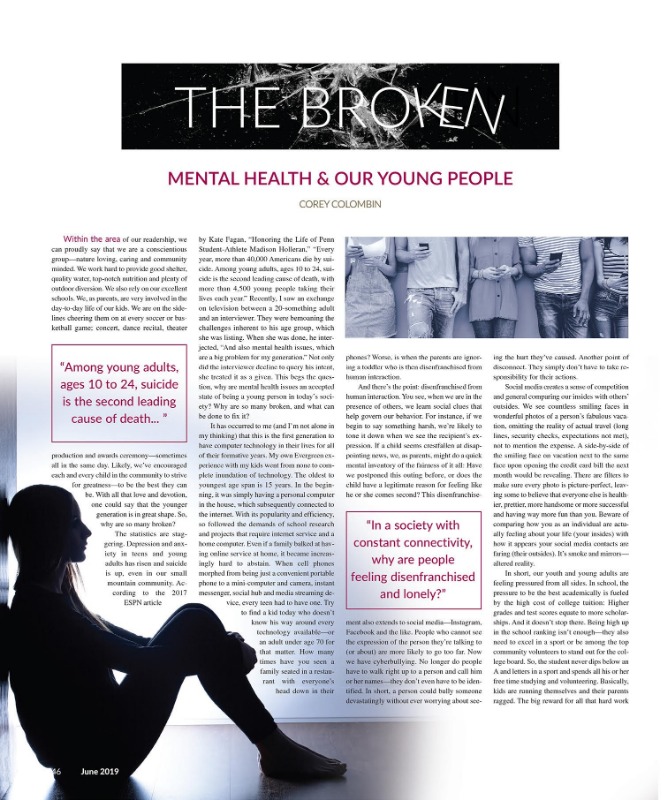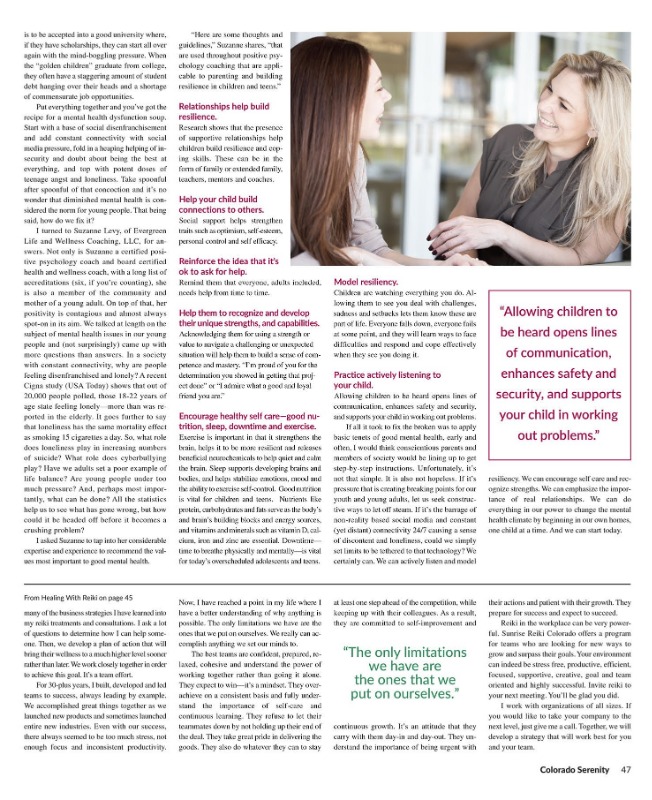- Posts: 621
- Thank you received: 18
- Forum
- Mountain Classifieds
- Free Business & Member Classifieds
- The Broken: An Article on Mental Health in Our Youth
The Broken: An Article on Mental Health in Our Youth
- ColoradoSerenity
-
 Topic Author
Topic Author
- Mountain Legend
-

Less
More
08 Jul 2019 14:32 #1
by ColoradoSerenity
coloradoserenity.com/
1524 Belford Court, Evergreen, CO 80439
303.670.5448
This email address is being protected from spambots. You need JavaScript enabled to view it.
Facebook
Instagram
Within the area of our readership, we can proudly say that we are a conscientious group—nature loving, caring and community minded. We work hard to provide good shelter, quality water, top-notch nutrition and plenty of outdoor diversion. We also rely on our excellent schools. We, as parents, are very involved in the day-to-day life of our kids. We are on the sidelines cheering them on at every soccer or basketball game; concert, dance recital, theater production and awards ceremony—sometimes all in the same day. Likely, we’ve encouraged each and every child in the community to strive for greatness—to be the best they can be. With all that love and devotion, one could say that the younger generation is in great shape. So, why are so many broken?
The statistics are staggering. Depression and anxiety in teens and young adults has risen and suicide is up, even in our small mountain community. According to the 2017 ESPN article by Kate Fagan, “Honoring the Life of Penn Student-Athlete Madison Holleran,” “Every year, more than 40,000 Americans die by suicide. Among young adults, ages 10 to 24, suicide is the second leading cause of death, with more than 4,500 young people taking their lives each year.” Recently, I saw an exchange on television between a 20-something adult and an interviewer. They were bemoaning the challenges inherent to his age group, which she was listing. When she was done, he interjected, “And also mental health issues, which are a big problem for my generation.” Not only did the interviewer decline to query his intent, she treated it as a given. This begs the question, why are mental health issues an accepted state of being a young person in today’s society? Why are so many broken, and what can be done to fix it?
It has occurred to me (and I’m not alone in my thinking) that this is the first generation to have computer technology in their lives for all of their formative years. My own Evergreen experience with my kids went from none to complete inundation of technology. The oldest to youngest age span is 15 years. In the beginning, it was simply having a personal computer in the house, which subsequently connected to the internet. With its popularity and efficiency, so followed the demands of school research and projects that require internet service and a home computer. Even if a family balked at having online service at home, it became increasingly hard to abstain. When cell phones morphed from being just a convenient portable phone to a mini-computer and camera, instant messenger, social hub and media streaming device, every teen had to have one. Try to find a kid today who doesn’t know his way around every technology available—or an adult under age 70 for that matter. How many times have you seen a family seated in a restaurant with everyone’s head down in their phones? Worse, is when the parents are ignoring a toddler who is then disenfranchised from human interaction.
And there’s the point: disenfranchised from human interaction. You see, when we are in the presence of others, we learn social clues that help govern our behavior. For instance, if we begin to say something harsh, we’re likely to tone it down when we see the recipient’s expression. If a child seems crestfallen at disappointing news, we, as parents, might do a quick mental inventory of the fairness of it all: Have we postponed this outing before, or does the child have a legitimate reason for feeling like he or she comes second? This disenfranchisement also extends to social media—Instagram, Facebook and the like. People who cannot see the expression of the person they’re talking to (or about) are more likely to go too far. Now we have cyberbullying. No longer do people have to walk right up to a person and call him or her names—they don’t even have to be identified. In short, a person could bully someone devastatingly without ever worrying about seeing the hurt they’ve caused. Another point of disconnect. They simply don’t have to take responsibility for their actions.
Social media creates a sense of competition and general comparing our insides with others’ outsides. We see countless smiling faces in wonderful photos of a person’s fabulous vacation, omitting the reality of actual travel (long lines, security checks, expectations not met), not to mention the expense. A side-by-side of the smiling face on vacation next to the same face upon opening the credit card bill the next month would be revealing. There are filters to make sure every photo is picture-perfect, leaving some to believe that everyone else is healthier, prettier, more handsome or more successful and having way more fun than you. Beware of comparing how you as an individual are actually feeling about your life (your insides) with how it appears your social media contacts are faring (their outsides). It’s smoke and mirrors—altered reality.
In short, our youth and young adults are feeling pressured from all sides. In school, the pressure to be the best academically is fueled by the high cost of college tuition: Higher grades and test scores equate to more scholarships. And it doesn’t stop there. Being high up in the school ranking isn’t enough—they also need to excel in a sport or be among the top community volunteers to stand out for the college board. So, the student never dips below an A and letters in a sport and spends all his or her free time studying and volunteering. Basically, kids are running themselves and their parents ragged. The big reward for all that hard work is to be accepted into a good university where, if they have scholarships, they can start all over again with the mind-boggling pressure. When the “golden children” graduate from college, they often have a staggering amount of student debt hanging over their heads and a shortage of commensurate job opportunities.
Put everything together and you’ve got the recipe for a mental health dysfunction soup. Start with a base of social disenfranchisement and add constant connectivity with social media pressure, fold in a heaping helping of insecurity and doubt about being the best at everything, and top with potent doses of teenage angst and loneliness. Take spoonful after spoonful of that concoction and it’s no wonder that diminished mental health is considered the norm for young people. That being said, how do we fix it?
I turned to Suzanne Levy, of Evergreen Life and Wellness Coaching, LLC, for answers. Not only is Suzanne a certified positive psychology coach and board certified health and wellness coach, with a long list of accreditations (six, if you’re counting), she is also a member of the community and mother of a young adult. On top of that, her positivity is contagious and almost always spot-on in its aim. We talked at length on the subject of mental health issues in our young people and (not surprisingly) came up with more questions than answers. In a society with constant connectivity, why are people feeling disenfranchised and lonely? A recent Cigna study (USA Today) shows that out of 20,000 people polled, those 18-22 years of age state feeling lonely—more than was reported in the elderly. It goes further to say that loneliness has the same mortality effect as smoking 15 cigarettes a day. So, what role does loneliness play in increasing numbers of suicide? What role does cyberbullying play? Have we adults set a poor example of life balance? Are young people under too much pressure? And, perhaps most importantly, what can be done? All the statistics help us to see what has gone wrong, but how could it be headed off before it becomes a crushing problem?
I asked Suzanne to tap into her considerable expertise and experience to recommend the values most important to good mental health.
“Here are some thoughts and guidelines,” Suzanne shares, “that are used throughout positive psychology coaching that are applicable to parenting and building resilience in children and teens.”
Relationships help build
resilience.
Research shows that the presence of supportive relationships help children build resilience and coping skills. These can be in the form of family or extended family, teachers, mentors and coaches.
Help your child build
connections to others.
Social support helps strengthen traits such as optimism, self-esteem, personal control and self efficacy.
Reinforce the idea that it’s ok to ask for help.
Remind them that everyone, adults included, needs help from time to time.
Help them to recognize and develop their unique strengths, and capabilities.
Acknowledging them for using a strength or value to navigate a challenging or unexpected situation will help them to build a sense of competence and mastery. “I’m proud of you for the determination you showed in getting that project done” or “I admire what a good and loyal friend you are.”
Encourage healthy self care—good nutrition, sleep, downtime and exercise.
Exercise is important in that it strengthens the brain, helps it to be more resilient and releases beneficial neurochemicals to help quiet and calm the brain. Sleep supports developing brains and bodies, and helps stabilize emotions, mood and the ability to exercise self-control. Good nutrition is vital for children and teens. Nutrients like protein, carbohydrates and fats serve as the body’s and brain’s building blocks and energy sources, and vitamins and minerals such as vitamin D, calcium, iron and zinc are essential. Downtime—time to breathe physically and mentally—is vital for today’s overscheduled adolescents and teens.
Model resiliency.
Children are watching everything you do. Allowing them to see you deal with challenges, sadness and setbacks lets them know these are part of life. Everyone falls down, everyone fails at some point, and they will learn ways to face difficulties and respond and cope effectively when they see you doing it.
Practice actively listening to your child.
Allowing children to be heard opens lines of communication, enhances safety and security, and supports your child in working out problems.
If all it took to fix the broken was to apply basic tenets of good mental health, early and often, I would think conscientious parents and members of society would be lining up to get step-by-step instructions. Unfortunately, it’s not that simple. It is also not hopeless. If it’s pressure that is creating breaking points for our youth and young adults, let us seek constructive ways to let off steam. If it’s the barrage of non-reality based social media and constant (yet distant) connectivity 24/7 causing a sense of discontent and loneliness, could we simply set limits to be tethered to that technology? We certainly can. We can actively listen and model resiliency. We can encourage self-care and recognize strengths. We can emphasize the importance of real relationships. We can do everything in our power to change the mental health climate by beginning in our own homes, one child at a time. And we can start today.
The statistics are staggering. Depression and anxiety in teens and young adults has risen and suicide is up, even in our small mountain community. According to the 2017 ESPN article by Kate Fagan, “Honoring the Life of Penn Student-Athlete Madison Holleran,” “Every year, more than 40,000 Americans die by suicide. Among young adults, ages 10 to 24, suicide is the second leading cause of death, with more than 4,500 young people taking their lives each year.” Recently, I saw an exchange on television between a 20-something adult and an interviewer. They were bemoaning the challenges inherent to his age group, which she was listing. When she was done, he interjected, “And also mental health issues, which are a big problem for my generation.” Not only did the interviewer decline to query his intent, she treated it as a given. This begs the question, why are mental health issues an accepted state of being a young person in today’s society? Why are so many broken, and what can be done to fix it?
It has occurred to me (and I’m not alone in my thinking) that this is the first generation to have computer technology in their lives for all of their formative years. My own Evergreen experience with my kids went from none to complete inundation of technology. The oldest to youngest age span is 15 years. In the beginning, it was simply having a personal computer in the house, which subsequently connected to the internet. With its popularity and efficiency, so followed the demands of school research and projects that require internet service and a home computer. Even if a family balked at having online service at home, it became increasingly hard to abstain. When cell phones morphed from being just a convenient portable phone to a mini-computer and camera, instant messenger, social hub and media streaming device, every teen had to have one. Try to find a kid today who doesn’t know his way around every technology available—or an adult under age 70 for that matter. How many times have you seen a family seated in a restaurant with everyone’s head down in their phones? Worse, is when the parents are ignoring a toddler who is then disenfranchised from human interaction.
And there’s the point: disenfranchised from human interaction. You see, when we are in the presence of others, we learn social clues that help govern our behavior. For instance, if we begin to say something harsh, we’re likely to tone it down when we see the recipient’s expression. If a child seems crestfallen at disappointing news, we, as parents, might do a quick mental inventory of the fairness of it all: Have we postponed this outing before, or does the child have a legitimate reason for feeling like he or she comes second? This disenfranchisement also extends to social media—Instagram, Facebook and the like. People who cannot see the expression of the person they’re talking to (or about) are more likely to go too far. Now we have cyberbullying. No longer do people have to walk right up to a person and call him or her names—they don’t even have to be identified. In short, a person could bully someone devastatingly without ever worrying about seeing the hurt they’ve caused. Another point of disconnect. They simply don’t have to take responsibility for their actions.
Social media creates a sense of competition and general comparing our insides with others’ outsides. We see countless smiling faces in wonderful photos of a person’s fabulous vacation, omitting the reality of actual travel (long lines, security checks, expectations not met), not to mention the expense. A side-by-side of the smiling face on vacation next to the same face upon opening the credit card bill the next month would be revealing. There are filters to make sure every photo is picture-perfect, leaving some to believe that everyone else is healthier, prettier, more handsome or more successful and having way more fun than you. Beware of comparing how you as an individual are actually feeling about your life (your insides) with how it appears your social media contacts are faring (their outsides). It’s smoke and mirrors—altered reality.
In short, our youth and young adults are feeling pressured from all sides. In school, the pressure to be the best academically is fueled by the high cost of college tuition: Higher grades and test scores equate to more scholarships. And it doesn’t stop there. Being high up in the school ranking isn’t enough—they also need to excel in a sport or be among the top community volunteers to stand out for the college board. So, the student never dips below an A and letters in a sport and spends all his or her free time studying and volunteering. Basically, kids are running themselves and their parents ragged. The big reward for all that hard work is to be accepted into a good university where, if they have scholarships, they can start all over again with the mind-boggling pressure. When the “golden children” graduate from college, they often have a staggering amount of student debt hanging over their heads and a shortage of commensurate job opportunities.
Put everything together and you’ve got the recipe for a mental health dysfunction soup. Start with a base of social disenfranchisement and add constant connectivity with social media pressure, fold in a heaping helping of insecurity and doubt about being the best at everything, and top with potent doses of teenage angst and loneliness. Take spoonful after spoonful of that concoction and it’s no wonder that diminished mental health is considered the norm for young people. That being said, how do we fix it?
I turned to Suzanne Levy, of Evergreen Life and Wellness Coaching, LLC, for answers. Not only is Suzanne a certified positive psychology coach and board certified health and wellness coach, with a long list of accreditations (six, if you’re counting), she is also a member of the community and mother of a young adult. On top of that, her positivity is contagious and almost always spot-on in its aim. We talked at length on the subject of mental health issues in our young people and (not surprisingly) came up with more questions than answers. In a society with constant connectivity, why are people feeling disenfranchised and lonely? A recent Cigna study (USA Today) shows that out of 20,000 people polled, those 18-22 years of age state feeling lonely—more than was reported in the elderly. It goes further to say that loneliness has the same mortality effect as smoking 15 cigarettes a day. So, what role does loneliness play in increasing numbers of suicide? What role does cyberbullying play? Have we adults set a poor example of life balance? Are young people under too much pressure? And, perhaps most importantly, what can be done? All the statistics help us to see what has gone wrong, but how could it be headed off before it becomes a crushing problem?
I asked Suzanne to tap into her considerable expertise and experience to recommend the values most important to good mental health.
“Here are some thoughts and guidelines,” Suzanne shares, “that are used throughout positive psychology coaching that are applicable to parenting and building resilience in children and teens.”
Relationships help build
resilience.
Research shows that the presence of supportive relationships help children build resilience and coping skills. These can be in the form of family or extended family, teachers, mentors and coaches.
Help your child build
connections to others.
Social support helps strengthen traits such as optimism, self-esteem, personal control and self efficacy.
Reinforce the idea that it’s ok to ask for help.
Remind them that everyone, adults included, needs help from time to time.
Help them to recognize and develop their unique strengths, and capabilities.
Acknowledging them for using a strength or value to navigate a challenging or unexpected situation will help them to build a sense of competence and mastery. “I’m proud of you for the determination you showed in getting that project done” or “I admire what a good and loyal friend you are.”
Encourage healthy self care—good nutrition, sleep, downtime and exercise.
Exercise is important in that it strengthens the brain, helps it to be more resilient and releases beneficial neurochemicals to help quiet and calm the brain. Sleep supports developing brains and bodies, and helps stabilize emotions, mood and the ability to exercise self-control. Good nutrition is vital for children and teens. Nutrients like protein, carbohydrates and fats serve as the body’s and brain’s building blocks and energy sources, and vitamins and minerals such as vitamin D, calcium, iron and zinc are essential. Downtime—time to breathe physically and mentally—is vital for today’s overscheduled adolescents and teens.
Model resiliency.
Children are watching everything you do. Allowing them to see you deal with challenges, sadness and setbacks lets them know these are part of life. Everyone falls down, everyone fails at some point, and they will learn ways to face difficulties and respond and cope effectively when they see you doing it.
Practice actively listening to your child.
Allowing children to be heard opens lines of communication, enhances safety and security, and supports your child in working out problems.
If all it took to fix the broken was to apply basic tenets of good mental health, early and often, I would think conscientious parents and members of society would be lining up to get step-by-step instructions. Unfortunately, it’s not that simple. It is also not hopeless. If it’s pressure that is creating breaking points for our youth and young adults, let us seek constructive ways to let off steam. If it’s the barrage of non-reality based social media and constant (yet distant) connectivity 24/7 causing a sense of discontent and loneliness, could we simply set limits to be tethered to that technology? We certainly can. We can actively listen and model resiliency. We can encourage self-care and recognize strengths. We can emphasize the importance of real relationships. We can do everything in our power to change the mental health climate by beginning in our own homes, one child at a time. And we can start today.
coloradoserenity.com/
1524 Belford Court, Evergreen, CO 80439
303.670.5448
This email address is being protected from spambots. You need JavaScript enabled to view it.
Please Log in or Create an account to join the conversation.
- Forum
- Mountain Classifieds
- Free Business & Member Classifieds
- The Broken: An Article on Mental Health in Our Youth
Time to create page: 0.165 seconds








